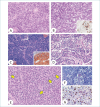Clinical needs and pathology's answers in neuroendocrine neoplasms of the lung
- PMID: 40574629
- PMCID: PMC12236144
- DOI: 10.32074/1591-951X-N1102
Clinical needs and pathology's answers in neuroendocrine neoplasms of the lung
Abstract
Lung neuroendocrine neoplasms (NENs) make up a variegated ensemble of malignancies encompassing typical carcinoid (TC) and atypical carcinoid (AC). These are low to intermediate grade neuroendocrine tumors (NETs), and large cell neuroendocrine carcinoma (LCNEC) and small cell lung carcinoma (SCLC), which are full-fledged high-grade neuroendocrine carcinomas (NECs) showing similar clinical outcomes. Through a peer interaction between oncologist and pathologist, we herein constructed a practical approach based on questioning and answering regarding 8 practical issues aimed to provide shared solutions for clinical decision-making. These issues were itemized as sequential steps guided by clinical reasoning and concerned differential diagnosis, combined subtypes, primary and metastatic tumors, small diagnostic material, predictive biomarkers, tumor staging and, lastly, standardizing terminology. This study takes advantage of the close interaction between oncologists and pathologists as a tool to better delineate the decision-making on lung NENs.
Keywords: diagnosis; lung; neuroendocrine neoplasms; oncology; pathology.
Copyright © 2025 Società Italiana di Anatomia Patologica e Citopatologia Diagnostica, Divisione Italiana della International Academy of Pathology.
Conflict of interest statement
The authors have no relevant affiliations or financial involvement with any organization or entity with a financial interest in or financial conflict with the subject matter or materials discussed in the manuscript. This includes employment, consultancies, honoraria, stock ownership or options, expert testimony, grants or patents received or pending, or royalties.
Figures


Similar articles
-
Clinical and biological heterogeneity of Grade 2 digestive neuroendocrine neoplasms: prognostic significance of the 10% Ki-67 index cutoff and implications for treatment strategies. A longitudinal study.J Endocrinol Invest. 2025 Jun;48(6):1483-1493. doi: 10.1007/s40618-025-02552-1. Epub 2025 Feb 19. J Endocrinol Invest. 2025. PMID: 39969798
-
Molecular markers help characterize neuroendocrine lung tumors.Ann Thorac Surg. 1996 Sep;62(3):798-809; discussion 809-10. doi: 10.1016/s0003-4975(96)00435-3. Ann Thorac Surg. 1996. PMID: 8784011
-
Systemic treatment for neuroendocrine non-small cell lung carcinoma: A cases series and a systematic review of the literature.Lung Cancer. 2023 Jul;181:107232. doi: 10.1016/j.lungcan.2023.107232. Epub 2023 May 10. Lung Cancer. 2023. PMID: 37216840
-
Prognostic and predictive significance of p53 and ATRX in neuroendocrine neoplasms of GIT and pancreas and their utility as an adjunct to accurate diagnosis-An eight-year retrospective study.Indian J Gastroenterol. 2025 Feb;44(1):95-102. doi: 10.1007/s12664-024-01678-z. Epub 2024 Oct 1. Indian J Gastroenterol. 2025. PMID: 39352684
-
Neuroendrocrine tumors of the uterine cervix: A therapeutic challenge for gynecologic oncologists.Gynecol Oncol. 2017 Mar;144(3):637-646. doi: 10.1016/j.ygyno.2016.12.003. Epub 2017 Jan 3. Gynecol Oncol. 2017. PMID: 28057354
References
-
- Borczuk C, Cooper W, Dacic S, et al. WHO Classification of Tumours: Thoracic tumours. International Agency for Research on Cancer; - Lyon (France); 2021.
-
- Vocino Trucco G, Righi L, Volante M, et al. Updates on lung neuroendocrine neoplasm classification. Histopathology 2024;84:67-85. https://doi.org/10.1111/his.15058 10.1111/his.15058 - DOI - PubMed
-
- Baudin E, Hayes AR, Scoazec JY, et al. Unmet Medical Needs in Pulmonary Neuroendocrine (Carcinoid) Neoplasms. Neuroendocrinology 2019;108:7-17. https://doi.org/10.1159/000493980 10.1159/000493980 - DOI - PubMed
-
- Caplin ME, Baudin E, Ferolla P, et al. Pulmonary neuroendocrine (carcinoid) tumors: European Neuroendocrine Tumor Society expert consensus and recommendations for best practice for typical and atypical pulmonary carcinoids. Ann Oncol 2015;26:1604-1620. https://doi.org/10.1093/annonc/mdv041 10.1093/annonc/mdv041 - DOI - PubMed
-
- Dingemans AC, Fruh M, Ardizzoni A, et al. Small-cell lung cancer: ESMO Clinical Practice Guidelines for diagnosis, treatment and follow-up(*). Ann Oncol 2021;32:839-853. https://doi.org/10.1016/j.annonc.2021.03.207 10.1016/j.annonc.2021.03.207 - DOI - PMC - PubMed

